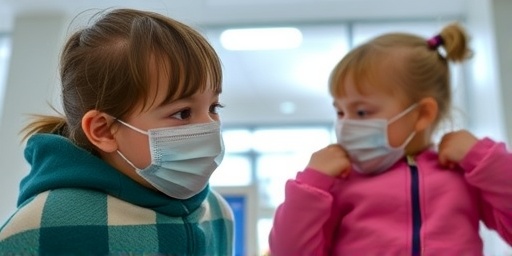Washington, DC – The Centers for Disease Control and Prevention (CDC) has sounded the alarm on a dramatic surge in RSV hospitalizations among US children, with infants and toddlers bearing the brunt of an unusually early winter wave. In the past two weeks alone, pediatric RSV cases have spiked by over 200% in several regions, overwhelming hospitals and prompting urgent public health recommendations for masking, rigorous hand hygiene, and limiting exposure for the most vulnerable.
- RSV Hospitalizations Double in Southern and Midwestern States
- CDC Rolls Out Targeted Precautions to Stem RSV Spread
- Early Winter RSV Wave Driven by Immunity Gaps and Behavioral Shifts
- New RSV Tools Offer Hope: From Monoclonal Antibodies to Maternal Vaccines
- Parents, Schools, and Policymakers Gear Up for Peak RSV Season
RSV, or Respiratory Syncytial Virus, is a common respiratory virus that typically peaks in winter but has arrived ahead of schedule this year, exacerbated by low immunity levels post-pandemic. CDC data shows hospitalizations for children under 5 jumping from fewer than 1,000 per week in late October to more than 4,500 by mid-November, marking one of the steepest rises on record.
RSV Hospitalizations Double in Southern and Midwestern States
The surge in RSV hospitalizations is hitting hardest in the South and Midwest, where warmer weather delayed typical flu and cold seasons but failed to stem the virus’s spread. According to the CDC’s Respiratory Illnesses Data Channel, states like Texas, Florida, Georgia, and Illinois report the sharpest increases. In Texas, for instance, pediatric RSV admissions at major children’s hospitals have doubled week-over-week, with Dallas Children’s Hospital treating over 150 RSV-positive infants in a single week – a 250% jump from last year.
“We’re seeing kids who were healthy just days ago now struggling to breathe,” said Dr. Maria Gonzalez, a pediatric pulmonologist at Texas Children’s Hospital. “RSV is filling our ICUs earlier than ever, and it’s not just the usual suspects – even vaccinated kids are showing up with severe cases.”
Nationwide, the CDC reports that children under 2 account for 77% of RSV hospitalizations this season, with infants younger than 6 months facing the highest risk of complications like bronchiolitis and pneumonia. Hospital data from the New Vaccine Surveillance Network (NVSN) indicates a 300% increase in RSV-positive admissions among toddlers compared to the 2022-2023 season at this point.
- Texas: RSV hospitalizations up 250%, ICUs at 90% capacity for pediatrics.
- Florida: Surge of 220%, with Miami Children’s Hospital diverting non-emergency cases.
- Illinois: 180% rise, straining resources amid concurrent flu uptick.
- National Trend: Weekly hospitalizations climbed from 577 (week ending Oct 28) to 4,827 (week ending Nov 18).
This isn’t isolated; similar patterns are emerging in California and New York, where urban density and school reopenings have accelerated transmission. The CDC emphasizes that while RSV is seasonal, this surge’s intensity rivals the 2021 “tripledemic” of RSV, flu, and COVID-19.
CDC Rolls Out Targeted Precautions to Stem RSV Spread
In response to the RSV surge, the CDC has issued specific, actionable guidelines aimed at children, parents, and communities. Top recommendations include universal masking in indoor public spaces for those around infants, frequent handwashing with soap for at least 20 seconds, and avoiding close contact with sick individuals.
“RSV spreads easily through respiratory droplets, and simple steps like masking and hand hygiene can reduce transmission by up to 50%,” stated CDC Director Dr. Mandy Cohen in an official alert. “Parents: Keep sick kids home, clean high-touch surfaces daily, and consider RSV immunizations for eligible babies.”
Additional CDC tips include:
- Avoid Crowds: Limit time in stores, daycare, or public transport during peak hours.
- Breastfeed if Possible: Antibodies in breast milk offer natural protection against severe RSV.
- Monitor Symptoms: Watch for fever, wheezing, rapid breathing, or poor feeding in infants – seek care immediately if present.
- Vaccination Push: Promote nirsevimab (Beyfortus) shots for infants under 8 months entering their first RSV season.
These measures echo successful strategies from the pandemic era, where masking slashed respiratory virus rates. Health officials note that compliance could prevent thousands of hospitalizations, especially as Thanksgiving gatherings loom.
Early Winter RSV Wave Driven by Immunity Gaps and Behavioral Shifts
Experts attribute the RSV surge to a perfect storm of factors. First, pandemic-era restrictions curtailed exposure, leaving many children – especially infants born during lockdowns – with underdeveloped immunity. “These kids missed the ‘natural priming’ from milder exposures,” explains Dr. Ruth Lynfield, a CDC advisor and infectious disease specialist.
Second, the early onset ties to weather anomalies: Unseasonably mild fall temperatures in the South kept people outdoors longer, fostering casual spread before indoor heating kicked in. Wastewater surveillance from Biobot Analytics detects RSV viral loads 5-10 times higher than baseline in 15 states.
Compounding this, overlapping flu and COVID waves are taxing diagnostics. “Many RSV cases get misattributed initially, delaying targeted interventions,” notes a report from the American Academy of Pediatrics (AAP). Data shows RSV positivity rates in pediatric tests hitting 15-20% in hotspots, up from 5% last season.
Historical context underscores the anomaly: Pre-pandemic, RSV peaked in January; now, it’s front-loading December pressures. The CDC’s modeling predicts 20,000-30,000 more pediatric hospitalizations by year-end if trends hold, rivaling flu burdens.
New RSV Tools Offer Hope: From Monoclonal Antibodies to Maternal Vaccines
Amid the surge, breakthroughs in RSV prevention are gaining traction. The FDA-approved monoclonal antibody nirsevimab (branded Beyfortus) provides 75-80% protection against hospitalization for infants, yet uptake lags at under 40% nationally due to cost and awareness barriers.
“Beyfortus is a game-changer – one dose lasts the season,” says Dr. Helen Chu, a University of Washington virologist. Administered via injection to babies under 8 months or high-risk toddlers up to 24 months, it’s credited with cutting severe cases by half in trial sites.
For pregnant women, the Abrysvo vaccine – given at 32-36 weeks gestation – passes antibodies to newborns, reducing infant hospitalizations by 82% per Pfizer trials. CDC urges OB-GYNs to prioritize it, targeting 2 million eligible pregnancies this season.
| RSV Protection Option | Target Group | Efficacy Against Hospitalization |
|---|---|---|
| Beyfortus (nirsevimab) | Infants <8 months | 75-80% |
| Abrysvo Vaccine | Pregnant women | 82% (infant protection) |
| Arexvy Vaccine | Adults 60+ | Indirect child protection |
Treatments remain supportive – oxygen, hydration, and antivirals like ribavirin for severe cases – but prevention is key. Insurers covering Beyfortus under the Vaccines for Children program could boost access, per AAP advocacy.
Parents, Schools, and Policymakers Gear Up for Peak RSV Season
As the RSV surge intensifies, stakeholders are mobilizing. Parent groups like Voices for Vaccines are launching awareness campaigns, sharing stories like that of 4-month-old Liam from Atlanta, hospitalized for a week with RSV pneumonia. “It was terrifying – fevers, retractions, oxygen masks,” his mother, Sarah Jenkins, told reporters. “If masking helps one family avoid this, it’s worth it.”
Schools in high-burden areas, such as those in Florida’s Broward County, are reinstating optional masking and enhanced cleaning protocols. Pediatricians report a 30% uptick in well-child visits for RSV risk assessments.
Looking ahead, the CDC forecasts the wave cresting in December, potentially syncing with flu peaks for a “quad-demic” risk including COVID and norovirus. Federal stockpiles of pediatric therapeutics are ramping up, and Congress is eyeing $500 million in RSV preparedness funding via the next spending bill.
Public health leaders call for vigilance: “This surge reminds us viruses don’t take holidays,” Dr. Cohen warned. “Sustained precautions through New Year’s could save lives and ease hospital strains.” With holidays approaching, families are advised to test before travel, stock up on home care kits, and consult providers on immunizations – steps that could blunt the worst of this RSV onslaught.









